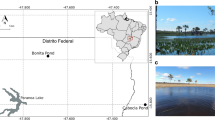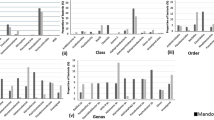Abstract
Purpose
The aim of this study was to observe how the effluents from a massive poultry farming facility influence the microbial community in the sediment of the nearby constructed wetland, which functions as a reservoir for poultry wastes.
Materials and methods
The microbial community structures and compositions in the two neighboring constructed wetlands of Louisiana (named Big Pond and Corner Pond) were characterized and compared through a metagenomics approach using the high-throughput sequence data of a conserved 16S rDNA region (V4 region) obtained from the sediment DNA samples and the metagenomics analysis tool QIIME. Big Pond is connected to a poultry farming facility, directly influenced by the poultry wastes, while its neighboring Corner Pond is separated from the poultry house.
Results and discussion
Among the 74 phyla of prokaryotes detected from the sediments of the two wetlands, four phyla (Acidobacteria, Chloroflexi, Euryarchaeota, and Proteobacteria) were predominant in both conditions. Proteobacteria, the most predominant phylum in both wetlands, was not significantly different in its relative abundance between the two conditions. However, Alphaproteobacteria, one of the four major classes within Proteobacteria, was almost depleted in Big Pond. Within another major phylum Euryarchaeota, all the three classes known as methanogenic organisms (Methanobacteria, Methanomicrobia, and Thermoplasmata) were more abundant in Big Pond. In addition, the relative abundance of Acidobacteria was significantly reduced in Big Pond, while that of the class Dehalococcoidetes within the phylum Chloroflexi was significantly higher in Big Pond compared to Corner Pond.
Conclusions
Wastes released from an intensive poultry farming facility change significantly the relative abundance of some taxonomic groups of microorganisms in the microbial community of the wetland sediment. This study provided valuable information about the global changes of microbial community in the wetland sediments caused by the infusion of poultry wastes at various taxonomic levels.








Similar content being viewed by others
References
Averhoff B, Muller V (2010) Exploring research frontiers in microbiology: recent advances in halophilic and thermophilic extremophiles. Res Microbiol 161:506–514
Braker G, Tiedje JM (2003) Nitric oxide reductase (norB) genes from pure cultures and environmental samples. Appl Environ Microbiol 69:3476–3483
Braskerud BC (2001) The influence of vegetation on sedimentation and resuspension of soil particles in small constructed wetlands. J Environ Qual 30:1447–1457
Bridgham SD, Johnston CA, Schubauer-Berigan JP, Weishampel P (2001) Phosphorus sorption dynamics in soils and coupling with surface and pore water in riverine wetlands. Soil Sci Soc Am J 65:577–588
Caporaso JG, Kuczynski J, Stombaugh J, Bittinger K, Bushman FD, Costello EK, Fierer N, Pena AG, Goodrich JK, Gordon JI, Huttley GA, Kelley ST, Knights D, Koenig JE, Ley RE, Lozupone CA, McDonald D, Muegge BD, Pirrung M, Reeder J, Sevinsky JR, Turnbaugh PJ, Walters WA, Widmann J, Yatsunenko T, Zaneveld J, Knight R (2010) QIIME allows analysis of high-throughput community sequencing data. Nat Methods 7:335–336
Caporaso JG, Lauber CL, Walters WA, Berg-Lyons D, Huntley J, Fierer N, Owens SM, Betley J, Fraser L, Bauer M, Gormley N, Gilbert JA, Smith G, Knight R (2012) Ultra-high-throughput microbial community analysis on the Illumina HiSeq and MiSeq platforms. ISME J 6:1621–1624
Dandie CE, Burton DL, Zebarth BJ, Trevors JT, Goyer C (2007) Analysis of denitrification genes and comparison of nosZ, cnorB and 16S rDNA from culturable denitrifying bacteria in potato cropping systems. Syst Appl Microbiol 30:128–138
Dowd BM, Press D, Los Huertos M (2008) Agricultural nonpoint source water pollution policy: the case of California’s Central Coast. Agric Ecosyst Environ 128:151–161
Elsayed OF, Maillard E, Vuilleumier S, Imfeld G (2014) Bacterial communities in batch and continuous-flow wetlands treating the herbicide S-metolachlor. Sci Total Environ 499:327–335
Enwall K, Philippot L, Hallin S (2005) Activity and composition of the denitrifying bacterial community respond differently to long-term fertilization. Appl Environ Microbiol 71:8335–8343
Findlay S, Groffman P, Dye S (2003) Effects of Phragmites australis removal on marsh nutrient cycling. Wetl Ecol Manag 11:157–165
Haller L, Tonolla M, Zopfi J, Peduzzi R, Wildi W, Pote J (2011) Composition of bacterial and archaeal communities in freshwater sediments with different contamination levels (Lake Geneva, Switzerland). Water Res 45:1213–1228
He J, Sung Y, Krajmalnik-Brown R, Ritalahti KM, Loffler FE (2005) Isolation and characterization of Dehalococcoides sp. strain FL2, a trichloroethene (TCE)- and 1,2-dichloroethene-respiring anaerobe. Environ Microbiol 7:1442–1450
Hollibaugh JT, Wong PS, Bano N, Pak SK, Prager EM, Orrego C (2001) Stratification of microbial assemblages in Mono Lake, California, and response to a mixing event. Hydrobiologia 466:45–60
Humayoun SB, Bano N, Hollibaugh JT (2003) Depth distribution of microbial diversity in Mono Lake, a meromictic soda lake in California. Appl Environ Microbiol 69:1030–1042
Jiang C, Sun B, Li HX, Jiang YJ (2013) Determinants for seasonal change of nematode community composition under long-term application of organic manure in an acid soil in subtropical China. Eur J Soil Biol 55:91–99
Kang MS, Srivastava P, Tyson T, Fulton JP, Owsley WF, Yoo KH (2008) A comprehensive GIS-based poultry litter management system for nutrient management planning and litter transportation. Comput Electron Agric 64:212–224
Koskiaho J, Ekholm P, Raty M, Riihimaki J, Puustinen M (2003) Retaining agricultural nutrients in constructed wetlands—experiences under boreal conditions. Ecol Eng 20:89–103
Krzmarzick MJ, McNamara PJ, Crary BB, Novak PJ (2013) Abundance and diversity of organohalide-respiring bacteria in lake sediments across a geographical sulfur gradient. FEMS Microbiol Ecol 84:248–258
Lever MA (2016) A new era of methanogenesis research. Trends Microbiol 24:84–86
Levy-Booth DJ, Prescott CE, Grayston SJ (2014) Microbial functional genes involved in nitrogen fixation, nitrification and denitrification in forest ecosystems. Soil Biol Biochem 75:11–25
Ligi T, Oopkaup K, Truu M, Preem JK, Nolvak H, Mitsch WJ, Mander U, Truu J (2014) Characterization of bacterial communities in soil and sediment of a created riverine wetland complex using high-throughput 16S rRNA amplicon sequencing. Ecol Eng 72:56–66
Loffler FE, Yan J, Ritalahti KM, Adrian L, Edwards EA, Konstantinidis KT, Muller JA, Fullerton H, Zinder SH, Spormann AM (2013) Dehalococcoides mccartyi gen. nov., sp. nov., obligately organohalide-respiring anaerobic bacteria relevant to halogen cycling and bioremediation, belong to a novel bacterial class, Dehalococcoidia classis nov., order Dehalococcoidales ord. nov. and family Dehalococcoidaceae fam. nov., within the phylum Chloroflexi. Int J Syst Evol Microbiol 63:625–635
Lozupone C, Knight R (2005) UniFrac: a new phylogenetic method for comparing microbial communities. Appl Env Microbiol 71:8228–8235
Marshall MM, Amos RN, Henrich VC, Rublee PA (2008) Developing SSU rDNA metagenomic profiles of aquatic microbial communities for environmental assessments. Ecol Indic 8:442–453
Mitsch WJ, Jorgensen SE (1989) Ecological engineering: an Introduction to ecotechnology. Wiley, New York.
O’Geen AT, Budd R, Gan J, Maynard JJ, Parikh SJ, Dahlgren RA (2010) Mitigating nonpoint source pollution in agriculture with constructed and restored wetlands. Adv Agron 108:1–76
Oren A (2014) Halophilic archaea on Earth and in space: growth and survival under extreme conditions. Philos Trans A Math Phys Eng Sci 372:2030
Overcash MR, Humenil FJ, Miner JR (1983) Livestock waste management. Vol 1. CRC Press, Boca Raton, FL
Pant HK, Reddy KR (2003) Potential internal loading of phosphorus in a wetland constructed in agricultural land. Water Res 37:965–972
Peacock AD, Mullen MD, Ringelberg DB, Tyler DD, Hedrick DB, Gale PM, White DC (2001) Soil microbial community responses to dairy manure or ammonium nitrate applications. Soil Biol Biochem 33:1011–1019
Poach ME, Hunt PG, Vanotti MB, Stone KC, Matheny TA, Johnson MH, Sadler EJ (2003) Improved nitrogen treatment by constructed wetlands receiving partially nitrified liquid swine manure. Ecol Eng 20:183–197
Quaiser A, Ochsenreiter T, Lanz C, Schuster SC, Treusch AH, Eck J, Schleper C (2003) Acidobacteria form a coherent but highly diverse group within the bacterial domain: evidence from environmental genomics. Mol Microbiol 50:563–575
Rabotyagov SS, Kling CL, Gassman PW, Rabalais NN, Turner RE (2014) The economics of dead zones: causes, impacts, policy challenges, and a model of the Gulf of Mexico hypoxic zone. Rev Environ Econ Policy 8:58–79
Rappe MS, Giovannoni SJ (2003) The uncultured microbial majority. Annu Rev Microbiol 57:369–394
Reddy KR, Kadlec RH, Flaig E, Gale PM (1999) Phosphorus retention in streams and wetlands: a review. Crit Rev Env Sci Tec 29:83–146
Rich JJ, Heichen RS, Bottomley PJ, Cromack K, Myrold DD (2003) Community composition and functioning of denitrifying bacteria from adjacent meadow and forest soils. Appl Environ Microbiol 69:5974–5982
Rysavy JP, Yan T, Novak PJ (2005) Enrichment of anaerobic polychlorinated biphenyl dechlorinators from sediment with iron as a hydrogen source. Water Res 39:569–578
Shutes RBE (2001) Artificial wetlands and water quality improvement. Environ Int 26:441–447
Sims A, Zhang YY, Galaraj S, Brown PB, Hu ZQ (2013) Toward the development of microbial indicators for wetland assessment. Water Res 47:1711–1725
Souza RC, Cantao ME, Vasconcelos ATR, Nogueira MA, Hungria M (2013) Soil metagenomics reveals differences under conventional and no-tillage with crop rotation or succession. Appl Soil Ecol 72:49–61
Sradnick A, Murugan R, Oltmanns M, Raupp J, Joergensen RG (2013) Changes in functional diversity of the soil microbial community in a heterogeneous sandy soil after long-term fertilization with cattle manure and mineral fertilizer. Appl Soil Ecol 63:23–28
Tanner CC, D’Eugenio J, McBride GB, Sukias JPS, Thompson K (1999) Effect of water level fluctuation on nitrogen removal from constructed wetland mesocosms. Ecol Eng 12:67–92
Urakawa H, Yoshida T, Nishimura M, Ohwada K (2000) Characterization of depth-related population variation in microbial communities of a coastal marine sediment using 16S rDNA-based approaches and quinone profiling. Environ Microbiol 2:542–554
Wu HP, Zeng GM, Liang J, Zhang JC, Cai Q, Huang L, Li XD, Zhu HN, Hu CX, Shen S (2013) Changes of soil microbial biomass and bacterial community structure in Dongting Lake: impacts of 50,000 dams of Yangtze River. Ecol Eng 57:72–78
Zhao XQ, Yang LY, Yu ZY, Peng NY, Xiao L, Yin DQ, Qin BQ (2008) Characterization of depth-related microbial communities in lake sediment by denaturing gradient gel electrophoresis of amplified 16S rRNA fragments. J Environ Sci China 20:224–230
Acknowledgments
This study was funded by USDA NIFA Hatch (Project no. LAB94285 for C. Y. Jeong and LAB94203 for J. H. Ham). We thank the Genomics Research Laboratory at Virginia Bioinformatics Institute (Blacksburg, VA) for the Illumina MiSeq sequencing of the sediment DNA samples.
Author information
Authors and Affiliations
Corresponding author
Additional information
Responsible editor: Haihan Zhang
Electronic supplementary material
ESM 1
(DOCX 35 kb)
Rights and permissions
About this article
Cite this article
Jeong, C.Y., Ham, J.H. Comparative analysis of the microbial community in the sediments of two constructed wetlands differentially influenced by the concentrated poultry feeding operations. J Soils Sediments 17, 557–566 (2017). https://doi.org/10.1007/s11368-016-1572-5
Received:
Accepted:
Published:
Issue Date:
DOI: https://doi.org/10.1007/s11368-016-1572-5




